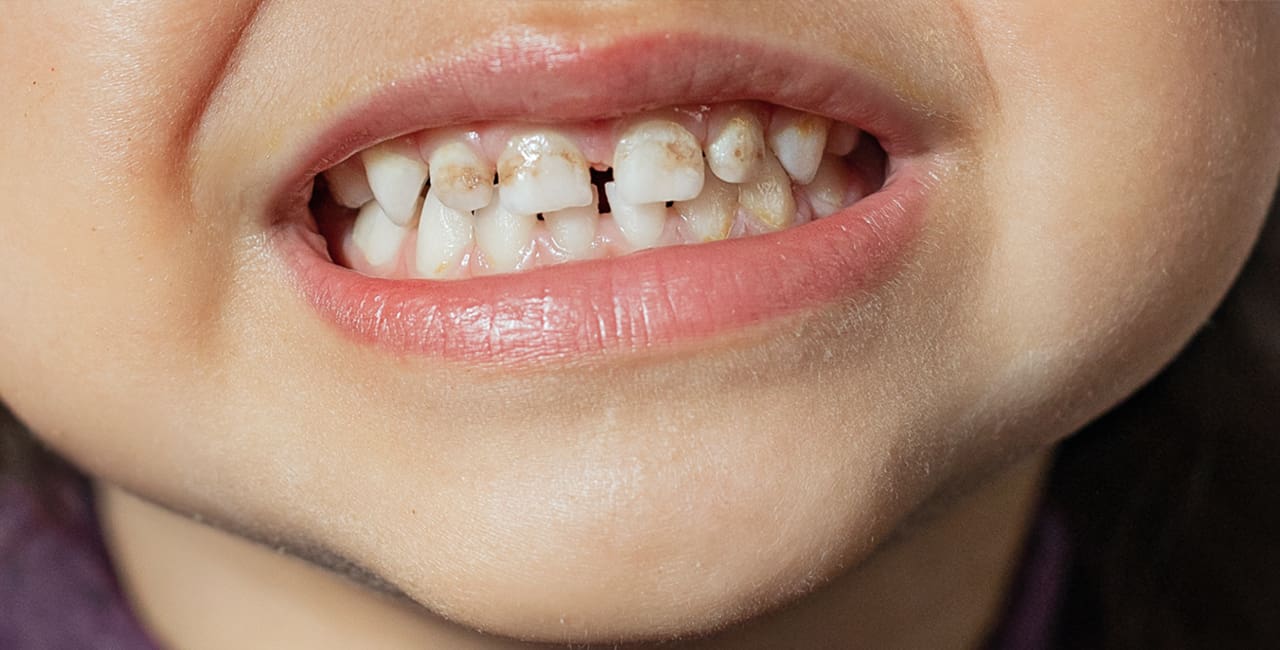Hypoplastic teeth, also known as hypomineralized teeth or enamel hypoplasia, can lead to weakened teeth that are more susceptible to decay and other dental problems.
Hypoplastic teeth can appear discolored, with white or brown spots on the enamel. They may also have cracks, pits or grooves on the surface and be worn down or chipped. Individuals with this condition usually experience tooth sensitivity.
Causes of Enamel Hypoplasia
Multiple factors can contribute to the development of enamel hypoplasia, including:
- Hereditary factors: Genetic conditions that affect enamel development such as Elli-van Creveld Syndrome and amelogensis imperfecta.
- Prenatal issues: Lack of prenatal care, mother with gestational diabetes, vitamin D deficiency or a mother that smoked during pregnancy.
- Premature birth: Enamel starts to form during fetal development, so premature birth can interrupt this process.
- Nutritional deficiencies: Vitamin A, C or D deficiency, calcium deficiency.
- Infectious diseases: Viral infections, bacterial infections during early childhood.
- Environmental factors: Exposure to toxins or acidic foods.
- Dental trauma: Injuries that affect the enamel’s development.
- Health conditions: Liver disease, celiac disease and cerebral palsy.
Treatment Options for Hypoplastic Teeth
Treating hypoplastic teeth requires a customized approach based on the severity of the enamel defect and the specific needs of the child. Some of the treatment options include:
- Dental crowns: A tooth-shaped cap that is placed over the affected tooth (teeth) to protect it from further damage and restore function.
- Dental fillings: Hypoplastic teeth are more prone to cavities. When tooth decay is removed from a tooth, it leaves a hole. A dental filling fills in the hole and restores the tooth’s shape and function. Silver fillings are sometimes preferred due to the bonding of resin to hypoplastic dentin/enamel.
- Palmetto Technique: This is used when the hypoplastic tooth is too broken down for a filling, but may not necessarily need a crown. An ortho band is fit and cemented to the tooth to provide additional structure. Glass Ionomer (GI) is then used to fill.
- Casein phosphopeptide amorphous calcium phosphate (CPP-ACP): This paste contains calcium and phosphate, which help strengthen the teeth’s enamel.
Caring for Hypoplastic Teeth
Good oral hygiene habits are crucial for maintaining healthy teeth, but even more so for children with hypoplastic teeth. Here are some tips to help care for your child’s hypoplastic teeth:
- Brush teeth twice a day with fluoride or hydroxyapatite toothpaste.
- Floss daily to remove plaque and food particles from between the teeth and under the gumline.
- Use a mouthwash with fluoride to help strengthen the enamel and prevent cavities.
- Limit acidic foods and drinks that can weaken the enamel.
- Schedule regular dental checkups and cleanings to monitor your child’s oral health and catch any issues early on.
🔑Key Takeaway
Hypoplastic teeth can be caused by a variety of factors and can lead to weakened, discolored and damaged teeth. Treatment options include dental crowns, dental fillings, the Palmetto Technique and CPP-ACP. Vitamin supplementation and a healthy diet are also important factors in treating hypoplastic teeth. Good oral hygiene habits help to prevent further damage or tooth decay.
FAQs About Hypoplastic Teeth
What is the best treatment for hypoplastic teeth?
The best treatment varies based on the severity of the hypoplastic teeth. This ranges from fillings, palmetto technique, crowns, and extraction.
What do hypoplastic teeth look like?
Hypoplastic teeth often appear smaller than usual, with irregular shapes or surfaces. They may have visible pits, grooves, or thin enamel, giving a rough and uneven look. Discoloration, such as white, yellow, or brown spots, is also common.
Can you reverse enamel hypoplasia?
Enamel hypoplasia cannot be reversed, but its effects can be managed with treatments like dental bonding or crowns to protect the teeth and improve their appearance.

